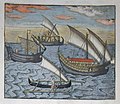Файл:Four Kind of Ships which Bantenese Use de Bry.jpg
Перейти до навігації
Перейти до пошуку

Розмір при попередньому перегляді: 691 × 600 пікселів. Інші роздільності: 277 × 240 пікселів | 553 × 480 пікселів | 885 × 768 пікселів | 1180 × 1024 пікселів | 1282 × 1113 пікселів.
Повна роздільність (1282 × 1113 пікселів, розмір файлу: 694 КБ, MIME-тип: image/jpeg)
Історія файлу
Клацніть на дату/час, щоб переглянути, як тоді виглядав файл.
| Дата/час | Мініатюра | Розмір об'єкта | Користувач | Коментар | |
|---|---|---|---|---|---|
| поточний | 14:02, 28 березня 2020 |  | 1282 × 1113 (694 КБ) | Verosaurus | Changes resolution |
| 09:46, 28 березня 2020 |  | 701 × 607 (260 КБ) | Verosaurus | {{Information |description ={{en|1=De Bry, Johann Theodor, (1560-1623) and Johann Israel de Bry (1565-1609). Part III, Plate 28, Shown are Four Kinds of Ships Which the Bantenese Use. From the "Little Voyages"<br><br>ASIAN VESSELS IN BANTAM<br>The illustration shows four different types of vessel in the harbor of the trading town of Bantam on the northwestern tip of Java. The vessel on the left, with the high running aft and the two yards is called a iuncos in the journal, which is also ca... |
Використання файлу
Такі сторінки використовують цей файл:
Глобальне використання файлу
Цей файл використовують такі інші вікі:
- Використання в en.wikipedia.org
- Використання в fr.wikipedia.org
- Використання в id.wikipedia.org
- Використання в ms.wikipedia.org